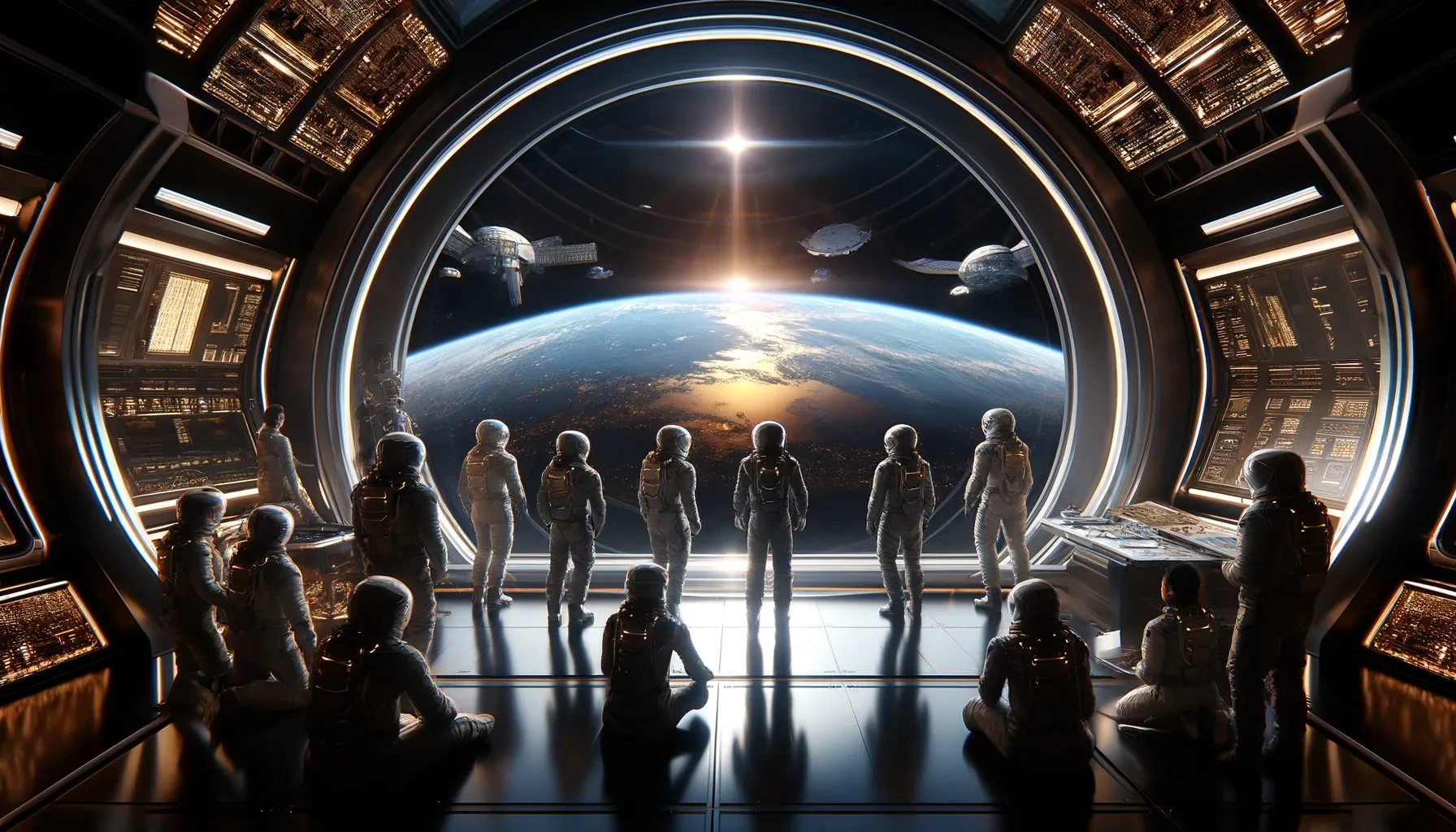The New Frontier: The Evolution and Future of Space Tourism
Space tourism represents one of the most thrilling frontiers in modern exploration, blending the allure of the unknown with the promise of accessible outer space travel for civilians. Defined broadly, space tourism refers to commercial activity that allows private individuals to travel beyond Earth's atmosphere. This concept has
Space tourism represents one of the most thrilling frontiers in modern exploration, blending the allure of the unknown with the promise of accessible outer space travel for civilians. Defined broadly, space tourism refers to commercial activity that allows private individuals to travel beyond Earth's atmosphere. This concept has transitioned from a mere science fiction fantasy to a tangible reality, driven by significant advancements in aerospace technology and entrepreneurship.
The roots of space tourism trace back to the early 20th century when the concept of human travel into space was primarily theoretical, discussed within the realms of literature and scientific circles. However, the real momentum began with the space race in the mid-20th century, culminating in the Apollo moon landings, which expanded the world's view on what was possible in space travel.
Despite these early explorations being government-led, the idea of commercial space travel started to gain traction in the late 20th century. Dennis Tito, an American businessman, became the first self-funded space tourist when he visited the International Space Station in 2001 aboard a Russian spacecraft. This monumental trip was facilitated by the commercial space company Space Adventures and cost Tito $20 million, signaling the birth of a new era where space was not just for astronauts but also for enthusiasts and adventurers with the means to pursue their dreams.
Since then, technological strides and entrepreneurial ventures by companies like SpaceX, Blue Origin, and Virgin Galactic have accelerated the pace of space tourism. These companies have developed spacecraft capable of not only reaching space but also ensuring the safe return of tourists, opening the gates to a new age of space travel. As we stand on the brink of this exciting industry's expansion, it's crucial to understand its trajectory from novelty to normalcy, driven by both passion and practical advancements in space technology.
The current landscape of space tourism is dominated by a few key players who have pioneered the commercial space industry with their innovative approaches and advanced spacecraft. These companies are not only making space more accessible but are also setting the stage for the future of extraterrestrial travel.
Key Players in the Industry:
- SpaceX: Founded by Elon Musk, SpaceX has been at the forefront of space innovation with its ambitious vision to make space travel affordable and eventually colonize Mars. SpaceX has developed the Falcon and Starship rockets, aiming to facilitate not only international travel on Earth but also interplanetary journeys. Their involvement in space tourism became more pronounced with the announcement of the first all-civilian space mission, Inspiration4, which orbited Earth in September 2021.
- Blue Origin: Founded by Jeff Bezos, Blue Origin focuses on making space travel more accessible through reusable launch vehicles. Their New Shepard rocket is designed specifically for suborbital spaceflights, offering passengers a few minutes of weightlessness and stunning views of Earth from the edge of space. Blue Origin completed its first crewed flight in July 2021, taking both Bezos and the oldest and youngest people ever to fly to space.
- Virgin Galactic: Richard Branson's Virgin Galactic targets suborbital space tourism, allowing passengers to experience several minutes of weightlessness. Virgin Galactic uses a unique air-launched spaceplane, VSS Unity, which is carried aloft by a twin-fuselage aircraft before firing its rocket motor to reach space. In July 2021, Branson himself was part of the crew on a successful crewed test flight, marking a significant milestone in commercial suborbital flight.
Types of Spaceflights:
- Suborbital Flights: These involve spacecraft reaching space without entering Earth’s orbit. Passengers on these flights experience several minutes of weightlessness and an unforgettable view of Earth's curvature. The flight is relatively short, usually lasting between one and two hours from takeoff to landing, making it the most accessible type of space tourism currently available.
- Orbital Flights: Far more complex and costly, orbital flights involve a spacecraft entering Earth's orbit and completing multiple orbits before returning. These missions can last from a few days to several weeks and offer a more in-depth space experience. Currently, orbital flights are less common for tourists due to the higher costs and increased logistical complexity.
As space tourism continues to develop, these key players are not just competing but also collaborating in various aspects to push the boundaries of what is possible in commercial space travel. Each type of flight offers unique experiences and caters to different segments of the space tourism market, gradually transforming the dream of space travel into a reality for more and more people around the world.
The burgeoning field of space tourism is built on the back of rapid technological advancements that have revolutionized spacecraft design, safety, and affordability. These innovations not only make space more accessible but also ensure that space travel meets rigorous safety standards, making it a viable option for non-professional astronauts.
Innovations Facilitating Space Tourism:
- Reusable Rocket Technology: One of the most significant advancements in space technology has been the development of reusable rockets, pioneered by companies like SpaceX and Blue Origin. Reusable launch vehicles can land back on Earth and be refurbished for multiple trips. This innovation drastically reduces the cost of access to space, which is crucial for the economic viability of space tourism.
- Advanced Propulsion and Materials: Modern spacecraft benefit from cutting-edge materials and propulsion technology. Composite materials that are lightweight yet durable enough to withstand the harsh conditions of space travel are crucial. Similarly, advancements in rocket propulsion technologies have improved the efficiency and reliability of spacecraft.
- Spacecraft Automation: Automation in spacecraft systems has made it possible for civilians without formal astronaut training to travel to space. Automated docking systems, flight path adjustments, and other critical functions ensure safety during the journey, minimizing the margin for human error.
Safety Measures and Training for Space Tourists:
- Pre-Flight Training: Space tourists undergo a condensed version of astronaut training, which includes familiarization with the spacecraft environment, safety procedures, and emergency protocols. This training ensures that passengers are prepared for the unique physical and psychological challenges of space travel.
- Health and Fitness Assessments: Potential space tourists must pass rigorous health and fitness assessments to ensure they can withstand the stresses of launch and re-entry, as well as the weightlessness experienced during flight. These assessments are crucial to prevent medical emergencies while in space.
- In-Flight Safety Systems: Spacecraft used for tourism are equipped with advanced life support systems and emergency safety measures. This includes redundant systems to handle life support in case of primary system failure, and escape systems designed to safely return the crew and passengers to Earth if necessary.
- Post-Flight Care: After returning from space, tourists receive medical evaluations and support to help them readjust to Earth's gravity. Post-flight care is essential to monitor the effects of space travel on the human body and ensure a healthy recovery.
These technological innovations and safety measures are integral to the ongoing development of space tourism, providing the necessary framework to make space travel as safe and enjoyable as possible for tourists. As technology continues to advance, it is likely that space tourism will become even more accessible and commonplace in the near future.
While the prospect of space tourism holds great promise, it also presents a set of significant challenges and considerations that need to be addressed to ensure sustainable and responsible growth in this industry.
Environmental Impact of Space Tourism:
- Rocket Emissions: Space launches generate substantial amounts of greenhouse gases and black carbon particles, which are released directly into the upper atmosphere. The potential cumulative effect of these emissions could be significant, impacting climate and atmospheric chemistry. As space tourism increases in frequency, the environmental impact of these emissions will become a critical concern.
- Atmospheric Pollution: Besides greenhouse gases, rocket launches also emit other pollutants such as alumina and various chemical compounds that can affect atmospheric layers. The deposition of these materials in the stratosphere could lead to unexpected changes in atmospheric dynamics and ozone layer depletion.
- Space Debris: Space tourism could contribute to the growing problem of space debris, which consists of defunct satellites, spent rocket stages, and other fragments. This debris poses a risk to both manned spacecraft and satellites, leading to potential collisions that could generate further debris, perpetuating a cycle that could limit safe access to space.
Regulatory and Ethical Considerations:
- Regulation of Space Traffic: As space tourism grows, effective regulation of space traffic will become increasingly important. This includes managing the launch and re-entry of spacecraft to minimize risks to both space tourists and uninvolved third parties. National and international bodies must work together to create comprehensive frameworks to regulate these activities.
- Access and Equity: There are significant ethical considerations concerning who gets to travel to space. Currently, space tourism is a privilege reserved for the wealthy. This raises questions about equity and the democratization of space. Ensuring broader access to this transformative experience requires addressing significant cost barriers and promoting inclusive policies.
- Informed Consent: Participants in space tourism must be fully informed of the risks associated with space travel. Unlike traditional terrestrial tourism, the risks here include potential life-threatening situations. Ensuring that tourists have a clear understanding and agree to these risks underlines the ethical necessity of informed consent in space tourism.
- Cultural and Heritage Sites in Space: As humans begin to visit and potentially inhabit places like the Moon or Mars, there will be discussions about the preservation of space heritage sites (such as lunar landing sites). It will be crucial to balance exploration and conservation.
Addressing these challenges and considerations is vital not only to the sustainability of space tourism but also to its ethical and equitable development. As the industry evolves, continuous dialogue among stakeholders—governments, private companies, scientists, and the public—is essential to navigate these complex issues effectively.
The next 10-15 years hold exciting potential for the development of space tourism, with advancements likely to transform the industry dramatically. From lunar tourism to the establishment of space habitats, the future of space tourism is poised to go beyond orbital flights.
Potential Developments in the Next 10-15 Years:
- Advanced Spacecraft and Propulsion Technologies: Continued innovations in spacecraft design and propulsion systems are expected to reduce costs further and enhance the safety and reliability of space travel. This could open up more frequent and affordable opportunities for space tourism.
- Commercial Space Stations: Several companies and international partnerships are exploring the idea of commercial space stations, which could serve as hotels or research facilities in orbit. These stations would provide longer-duration stays in space, offering more in-depth experiences than current orbital or suborbital flights.
- Integration of Artificial Intelligence and Robotics: The integration of AI and robotics in space travel will likely advance operational efficiencies and safety. Robots could perform routine maintenance and emergency repairs on spacecraft and habitats, while AI could manage systems operations, improving the overall safety and comfort of space tourists.
The Concept of Lunar Tourism and Space Habitats:
- Lunar Tourism: Proposals for lunar tourism are becoming more concrete, with companies like SpaceX and national space agencies considering missions that could take tourists around or to the Moon. While significant challenges still need to be overcome, including the high costs and technical hurdles associated with lunar landings, the allure of walking on the Moon could drive substantial investment and interest in the coming years.
- Space Habitats: The long-term vision of space habitats involves constructing environments in space that can support human life for extended periods. These habitats would not only facilitate long-term human presence in space but also function as hubs for further exploration of Mars and other destinations. Architectural and engineering innovations are necessary to create sustainable living conditions, from generating reliable sources of food and water to ensuring effective waste management and radiation protection.
- Sustainable Space Ecosystems: The development of closed-loop life support systems and renewable energy sources in space habitats will be crucial for the sustainability of long-term space habitation. These systems will mimic Earth’s natural ecological cycles to provide everything needed for human survival, reducing the reliance on Earth for resupply missions.
The future of space tourism is linked closely with broader goals of human expansion into space. As technology advances and costs decrease, the dream of widespread space travel could become a reality, allowing more people to experience the wonders of the cosmos. The next decade will likely be a pivotal period for testing these concepts and beginning their practical implementation.
The economic implications of space tourism are substantial, with the potential to create a significant new industry that could rival traditional sectors in scale and impact. As technology advances and costs decrease, the market for space tourism is expected to expand, bringing a wealth of opportunities for economic growth and investment.
Potential Market Size and Economic Impact of Space Tourism:
- Market Growth: Analysts predict that the space tourism market could be worth billions of dollars in the next decade. As more people gain access to space experiences and the cost of launches decreases, demand is expected to grow. This expansion is not only limited to actual space travel but also extends to subsidiary industries such as spacecraft manufacturing, training facilities, and spaceport operations.
- Job Creation: The growth of space tourism is expected to create thousands of jobs across various sectors. These include direct jobs in aerospace engineering, mission planning, and support roles, as well as indirect jobs in tourism, hospitality, and media. The development of infrastructure to support space tourism, such as spaceports and training centers, will also contribute significantly to local and international economies.
- Technological Spillover: Investments in space tourism can lead to technological advances that have broader applications. Innovations developed for space travel, such as improved propulsion systems and life-support technologies, can have spillover effects into other industries, improving energy efficiency, materials science, and robotic automation.
Investment Trends and the Role of Private Funding in Space Exploration:
- Increasing Private Investment: The space sector has seen a surge in private investment, with billionaires and venture capitalists betting big on the future of space tourism. Companies like SpaceX, Blue Origin, and Virgin Galactic have invested heavily in developing spacecraft and infrastructure. This trend is likely to continue as the commercial potential of space tourism becomes more apparent.
- Public-Private Partnerships: Governments are increasingly entering into partnerships with private companies to advance space exploration. These collaborations can help reduce the financial burden on public funds while accelerating innovation and deployment of space technologies. Public-private partnerships also allow for sharing risks and benefits, making ambitious projects like lunar habitats and Mars missions more feasible.
- Global Investment Interest: Space tourism has garnered global interest, with countries like the UAE, China, and Russia investing in space tourism ventures. This international investment contributes to the development of a global space economy and fosters cooperation across borders.
The economic potential of space tourism extends far beyond the immediate revenue from tourist flights. It encompasses a wide range of industries and activities, from advanced manufacturing and technological research to international collaboration and economic development. As this sector matures, it could become a significant component of the global economy, providing new frontiers for growth and innovation.
Space tourism not only promises thrilling experiences but also offers significant educational and cultural impacts that can enrich public knowledge and foster a deeper connection with space exploration.
Opportunities for Educational Outreach and Public Engagement:
- Inspiring the Next Generation: Space tourism can serve as a powerful educational tool, inspiring students and young people to pursue careers in STEM (Science, Technology, Engineering, and Mathematics). Witnessing tourists venture into space can ignite curiosity and passion for space and science, similar to the Apollo missions' impact on the 1960s and 1970s generations.
- Hands-On Learning Experiences: As space tourism becomes more accessible, educational programs can integrate space-themed modules and potentially provide hands-on experiences such as zero-gravity flights or visits to spaceports. These programs could offer students a tangible connection to space sciences, enhancing their understanding and interest.
- Public Lectures and Workshops: Space tourism companies can collaborate with educational institutions to host lectures, workshops, and seminars that delve into the technology, physics, and potential of space travel. These events can be pivotal in educating the public about the complexities and achievements of space exploration.
The Cultural Significance of Making Space More Accessible to Diverse Populations:
- Democratizing Space: By making space accessible to non-astronauts, space tourism democratizes an experience once reserved for a select few highly trained individuals. This shift can have profound cultural implications, promoting a more inclusive view of who can participate in space exploration.
- Global Perspective and Unity: Viewing Earth from space often has a profound impact on individuals, fostering a sense of global citizenship and unity. This "Overview Effect," a cognitive shift in awareness reported by astronauts, can also influence space tourists, who may return with renewed perspectives on Earth’s fragility and the importance of global cooperation.
- Cultural Diversity in Space: As space travel becomes more accessible, it could also become more culturally diverse. This diversity will enrich the space community, bringing a variety of cultural perspectives to the discussion and development of space policies and practices. It ensures that multiple voices are heard in the shaping of this new frontier, from policy-making to future space missions.
- Art and Media: Space tourism can influence art and media, creating new genres and themes that reflect humanity’s relationship with space. Films, literature, art, and music inspired by space tourism can help disseminate space-related themes to a broader audience, enhancing public engagement and appreciation.
The educational and cultural impacts of space tourism are vast and varied. They extend beyond the immediate participants to influence society at large, shaping educational content, cultural perceptions, and international cooperation. By fostering a broader understanding and appreciation of space, space tourism can play a pivotal role in shaping a future where space is viewed as a common heritage of all humankind.
Space tourism is rapidly transitioning from a futuristic fantasy into a tangible reality, offering unprecedented opportunities for exploration, education, and economic development. This emerging industry, led by pioneering companies like SpaceX, Blue Origin, and Virgin Galactic, is not just about providing extraordinary experiences but also about shaping the future of human activity in space.
Summary of Key Points Discussed:
- Technological Advances: Innovations such as reusable rockets, advanced materials, and spacecraft automation have reduced costs and increased the safety of space travel, making it more accessible to the general public.
- Economic Impact: The growth of space tourism is expected to generate significant economic benefits, including job creation, technological spillover, and new market opportunities, thereby becoming a substantial part of the global economy.
- Challenges and Considerations: Despite its potential, space tourism faces environmental, regulatory, and ethical challenges that need careful management to ensure sustainable development.
- Educational and Cultural Influence: Space tourism holds the potential to inspire future generations, promote global unity, and enrich our cultural perspectives on space exploration.
Reflection on the Future Trajectory of Space Tourism and Its Role in Human Exploration:
Looking ahead, the trajectory of space tourism is set to profoundly influence human presence in outer space. As technology continues to evolve and costs decline, we can anticipate more frequent and diverse space tourism activities, including orbital and lunar missions. These advancements will not only make space more accessible but also more integral to how we live and work.
The cultural impact of space tourism, especially the democratization of space travel, will likely shift societal perceptions about space, promoting a more inclusive mindset towards who can be an explorer. As more people from diverse backgrounds experience the Overview Effect, the global community's awareness of our planet's vulnerability and the necessity for sustainable practices might deepen, leading to more concerted global efforts in environmental conservation and space sustainability.
In conclusion, the evolution of space tourism represents a significant step forward in human exploration, not merely extending where we can go but also enhancing our understanding and stewardship of Earth. As this exciting field grows, it will continue to challenge our abilities and imagination, paving the way for a future where space is a realm not just for scientific exploration but for all to experience and cherish.





